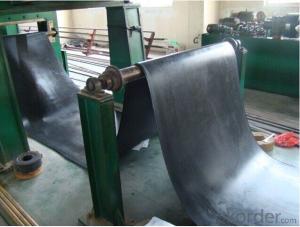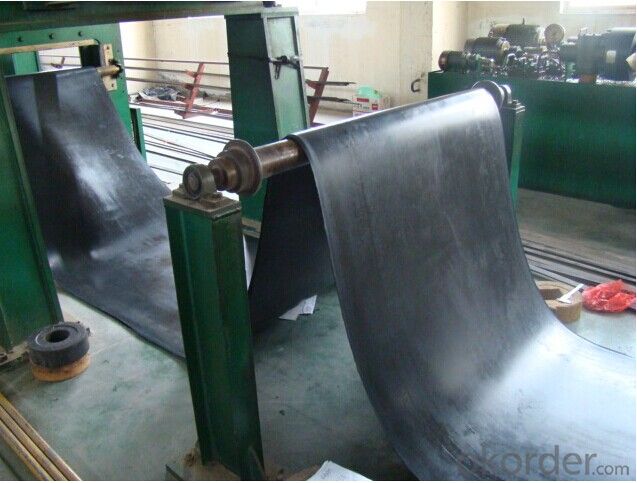EPDM Rubber Roofing Waterproof Membrane with 1.2mm/1.5mm/2.0mm
- Loading Port:
- Qingdao
- Payment Terms:
- TT OR LC
- Min Order Qty:
- 2000 m²
- Supply Capability:
- 300000 m²/month
OKorder Service Pledge
OKorder Financial Service
You Might Also Like
EPDM Waterproof Membrane
Introduction for EPDM Waterproof Membrane
EPDM waterproof membrane is of high elasticity among high polymer waterproof materials and becomes a world-popular waterproofing material.
Our EPDM waterproof membrane is made from ternary ethylene-propylene rubber, which is designed for waterproofing of exposed and non-exposed applications.
Our EPDM waterproof membrane production adopts the world-advanced equipment of cold feeding extrusion and continuous vulcanization technology.
Characteristics for EPDM Waterproof Membrane
1 Excellent physical and mechanical performance
2 High tearing resistance
3 Good deformation adaptability
4 High puncture resistance
5 High aging resistance
6 High UV resistance
Uses for EPDM Waterproof Membrane
l Roofs, Basement, Toilet
l Industrial and civil building waterproofing
l Geosynthetic liner for swimming pool, channels, irrigation system
l Especially suit for projects with high requirements in durability, anti-corrosion and deformation
Specification for EPDM Waterproof Membrane
Type | EPDM Waterproof Membrane | |||
Material | EPDM Rubber | |||
Thickness | 1.0mm | 1.2mm | 1.5mm | 2.0mm |
Size | 1.2m(width) * 20m(length)/roll | |||
Type | Vulcanized | |||
Pattern | Non-reinforced(homogeneous) | |||
Packing | 24sqm--80sqm/roll, with plastic bag | |||
Color | Black | |||
Application | Roofs, basement, pond, Lake, steel structure roof, swimming pool, underground, tunnel, etc | |||
Technical Data for EPDM Waterproof Membrane
Item | value | ||
JL1 | JF1 | ||
Tensile Strength (Mpa) | normal tamperature | 7.5 | 4.0 |
60°C ≥ | 2.3 | 0.8 | |
Elongation at break (%) | normal tamperature ≥ | 450 | 450 |
-20°C ≥ | 200 | 200 | |
Tear Resistance (N) | ≥ | 25 | 18 |
Water impermeability | 30mm | 0.3Mpa | 0.3Mpa |
Cold bending | (°C) ≤ | -40 | -30 |
Heating Shrinking rate | extand << span=""> | 2 | 2 |
shrink << span=""> | 4 | 4 | |


FAQ:
Can you produce 4m width?
Yes, no problem for us. We have four bases in China, largest one in this field.
How many quantity in one 20'' container for 1.2mm and 1.5mm?
480rolls, 11520m2 for 1.2mm and 400rolls, 9600m2 for 1.5mm
Can you provide free samples?
Yes, our samples are free, but express fees usually on buyer's account.
- Q: Can a waterproofing membrane be applied on curved surfaces?
- Yes, a waterproofing membrane can be applied on curved surfaces. The flexibility and adaptability of the membrane allow it to conform to different shapes and curves, ensuring effective waterproofing protection even on irregular surfaces.
- Q: Are waterproofing membranes resistant to mineral oils?
- Waterproofing membranes can vary in their resistance to mineral oils. Some waterproofing membranes are specifically designed to be resistant to mineral oils, while others may not be. It is important to check the specifications and product information provided by the manufacturer to determine the resistance of a particular waterproofing membrane to mineral oils. Additionally, it is recommended to consult with a professional or the manufacturer directly for specific guidance on the compatibility of a waterproofing membrane with mineral oils in your specific application.
- Q: How do waterproofing membranes prevent water leakage?
- Waterproofing membranes are designed to prevent water leakage by creating a barrier between the surface and the water. These membranes are typically made of materials such as bitumen, PVC, or EPDM, and are applied to the surface in a liquid or sheet form. The primary way in which waterproofing membranes prevent water leakage is by forming a continuous and impermeable layer. This layer acts as a physical barrier that prevents water from seeping through the surface. The membranes are applied in such a way that they cover the entire surface, including joints, cracks, and seams, ensuring that there are no areas vulnerable to water penetration. Additionally, waterproofing membranes often have excellent adhesive properties, allowing them to bond tightly to the surface. This ensures that there are no gaps or spaces where water could enter. By adhering tightly to the surface, the membranes also provide protection against the movement of water vapor, preventing moisture buildup and potential damage to the structure. Furthermore, waterproofing membranes are specifically designed to be highly resistant to water and moisture. They are made from materials that do not degrade or deteriorate when exposed to water, ensuring their longevity and effectiveness. This resistance to water also helps to prevent the membrane from becoming permeable over time. In summary, waterproofing membranes prevent water leakage by creating a continuous and impermeable barrier on the surface. They cover the entire surface, adhere tightly to prevent gaps, and are resistant to water and moisture. By implementing these measures, waterproofing membranes provide reliable protection against water infiltration and subsequent damage.
- Q: Can a waterproofing membrane be used in conjunction with drainage systems?
- Yes, a waterproofing membrane can be used in conjunction with drainage systems. The membrane provides a barrier to prevent water penetration, while the drainage system helps to channel and remove any water that may accumulate. This combination ensures effective and comprehensive waterproofing for various applications such as basements, roofs, and underground structures.
- Q: Can a waterproofing membrane be used for underwater structures?
- Indeed, underwater structures can benefit from the utilization of a waterproofing membrane. These membranes have been specifically engineered to create a formidable barrier against water infiltration, rendering them appropriate for various applications, including underwater structures. Typically composed of robust materials like reinforced PVC or rubber, these membranes possess exceptional water resistance capabilities and effectively safeguard submerged surfaces by forming a reliable seal. Whether it be a swimming pool, underwater tunnel, or offshore platform, the implementation of a waterproofing membrane can effectively thwart water ingress and preserve the structural integrity. Nonetheless, it is crucial to ascertain that the chosen waterproofing membrane has been meticulously crafted and thoroughly tested for underwater applications to guarantee optimal performance and longevity.
- Q: Can a waterproofing membrane be used for vehicular traffic areas?
- Vehicular traffic areas can benefit from the use of a waterproofing membrane. These membranes are specifically designed to create a barrier that prevents water from seeping through and causing damage to surfaces. In areas like parking decks or driveways, it is crucial to protect the underlying structure from water infiltration, which can lead to corrosion, deterioration, and expensive repairs. By utilizing a waterproofing membrane that is specifically designed for vehicular traffic, the surface can be effectively safeguarded from water damage, as well as other potential contaminants such as oil and chemicals. These membranes are typically more durable and capable of withstanding the weight and impact of vehicles, ensuring long-lasting protection. Furthermore, certain waterproofing membranes even offer slip-resistant properties, making them suitable for areas where vehicles require traction. Nevertheless, it is important to seek guidance from a professional to determine the appropriate waterproofing membrane and installation method for specific vehicular traffic areas, taking into account factors such as traffic volume, load capacity, and climate conditions.
- Q: Can a waterproofing membrane be used in bathrooms or showers?
- Certainly, bathrooms or showers can benefit from the use of a waterproofing membrane. In fact, it is strongly advised to incorporate a waterproofing membrane in these spaces to avert water damage and leakage. By serving as a barrier, the waterproofing membrane obstructs water from infiltrating through the walls, floors, and other surfaces in the bathroom or shower. Normally, it is applied prior to tiling or finishing the surfaces, offering an additional shield against moisture and guaranteeing that the underlying structure remains free from dampness. This not only aids in preventing the growth of mold and mildew but also extends the lifespan of the bathroom or shower.
- Q: Can a waterproofing membrane be used for stadiums or sports fields?
- Yes, a waterproofing membrane can be used for stadiums or sports fields. Waterproofing membranes are commonly used in construction to protect structures from water damage, including stadiums and sports fields. These membranes provide a barrier against water penetration, ensuring the longevity and durability of the facility. They can effectively prevent water leakage, dampness, and other moisture-related issues, ultimately preserving the integrity of the playing surface and the safety of athletes and spectators.
- Q: Can a waterproofing membrane be used in food processing or pharmaceutical facilities?
- Food processing and pharmaceutical facilities can make use of a waterproofing membrane. These facilities often rely on waterproofing membranes to keep the surroundings dry and prevent water damage. By creating a barrier against moisture, these membranes ensure that leaks and water penetration are avoided. This becomes particularly crucial in environments where hygiene and cleanliness are of utmost importance, like food processing and pharmaceutical facilities. Furthermore, these waterproofing membranes can be applied to floors, walls, and ceilings, guaranteeing comprehensive protection. They are also commonly made from materials that resist chemicals and bacteria growth, making them even more suitable for use in sensitive environments. Ultimately, incorporating a waterproofing membrane in food processing or pharmaceutical facilities proves to be an effective method of maintaining a dry and safe environment for the production of high-quality products.
- Q: Can a waterproofing membrane be used for pond or pool applications?
- Yes, a waterproofing membrane can be used for pond or pool applications. Waterproofing membranes are designed to provide a barrier against water penetration, making them an ideal choice for sealing ponds and pools. These membranes are typically made from synthetic materials such as PVC, EPDM, or TPO, which are highly resistant to water and UV rays. They are available in various thicknesses and can be customized to fit the specific dimensions of the pond or pool. Additionally, waterproofing membranes are durable and flexible, allowing them to withstand the constant exposure to water and the movement of the underlying substrate. Overall, using a waterproofing membrane for pond or pool applications can help prevent leaks, prolong the lifespan of the structure, and ensure a safe and enjoyable water environment.
Send your message to us
EPDM Rubber Roofing Waterproof Membrane with 1.2mm/1.5mm/2.0mm
- Loading Port:
- Qingdao
- Payment Terms:
- TT OR LC
- Min Order Qty:
- 2000 m²
- Supply Capability:
- 300000 m²/month
OKorder Service Pledge
OKorder Financial Service
Similar products
Hot products
Hot Searches
Related keywords



























